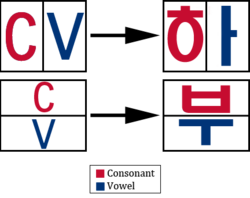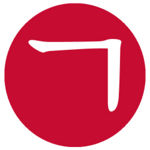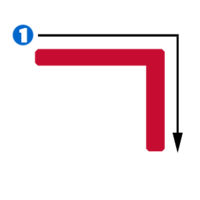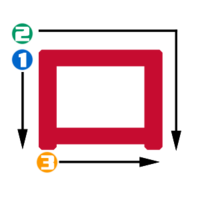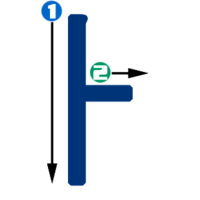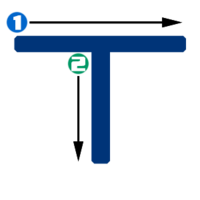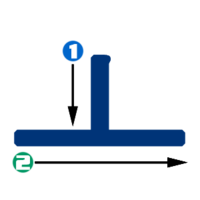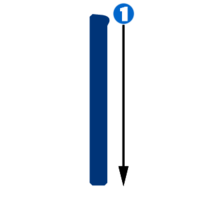Difference between revisions of "Hangeul step 2/fr"
(→Introduction) |
(→Étape 2) |
||
| Line 18: | Line 18: | ||
{{-}} | {{-}} | ||
| − | == | + | ==Étape 2== |
{{Hangeul intro table | {{Hangeul intro table | ||
|bgcolor = {{kred}} | |bgcolor = {{kred}} | ||
|Consonant = ㄱ | |Consonant = ㄱ | ||
|Cons image = ㄱ.jpg | |Cons image = ㄱ.jpg | ||
| − | |Cons text = | + | |Cons text = Prononcée entre G et K au début d'un mot. Cependant, lorsqu'elle se trouve entre deux voyelles, elle est prononcée /g/. Pour plus d'informations, voir [[ㄱ]]. |
|Vowel = ㅏ | |Vowel = ㅏ | ||
|Vowel image = ㅏ.jpg | |Vowel image = ㅏ.jpg | ||
| − | |Vowel text = | + | |Vowel text = Voyelle horizontale écrite à droite de la consonne. Pour plus d'informations, voir [[ㅏ]]. |
| − | |Vowel audio description1 = | + | |Vowel audio description1 = Homme |
|Vowel audio1 = <flashmp3>a H.mp3|leftbg=003478|rightbg=c60c30|lefticon=ffffff|righticon=ffffff</flashmp3> | |Vowel audio1 = <flashmp3>a H.mp3|leftbg=003478|rightbg=c60c30|lefticon=ffffff|righticon=ffffff</flashmp3> | ||
| − | |Vowel audio description2 = | + | |Vowel audio description2 = Femme |
|Vowel audio2 = <flashmp3>a M.mp3|leftbg=003478|rightbg=c60c30|lefticon=ffffff|righticon=ffffff</flashmp3> | |Vowel audio2 = <flashmp3>a M.mp3|leftbg=003478|rightbg=c60c30|lefticon=ffffff|righticon=ffffff</flashmp3> | ||
}} | }} | ||
| Line 35: | Line 35: | ||
{| class="wikitable" style="text-align:center; margin-left: auto; margin-right: auto; font-size:300%;" | {| class="wikitable" style="text-align:center; margin-left: auto; margin-right: auto; font-size:300%;" | ||
|-style="font-size:70%" | |-style="font-size:70%" | ||
| − | !colspan="2"| | + | !colspan="2"|Entraînement |
|- | |- | ||
| 가 | | 가 | ||
| Line 47: | Line 47: | ||
|Consonant = ㄴ | |Consonant = ㄴ | ||
|Cons image = ㄴ.jpg | |Cons image = ㄴ.jpg | ||
| − | |Cons text = | + | |Cons text = Prononcée comme N en français. Pour plus d'informations, voir [[ㄴ]]. |
|Vowel = ㅜ | |Vowel = ㅜ | ||
|Vowel image = ㅜ.jpg | |Vowel image = ㅜ.jpg | ||
| − | |Vowel text = | + | |Vowel text = Ce son est semblable au son "OU" français ou "OO" anglais (par exemple m'''oo'''n) ou "U" espagnol (par exemple ''usted"). Voyelle verticale écrite sous la consonne. Pour plus d'informations, voir [[ㅜ]]. |
| − | |Vowel audio description1 = | + | |Vowel audio description1 = Homme |
|Vowel audio1 = <flashmp3>u H.mp3|leftbg=003478|rightbg=c60c30|lefticon=ffffff|righticon=ffffff</flashmp3> | |Vowel audio1 = <flashmp3>u H.mp3|leftbg=003478|rightbg=c60c30|lefticon=ffffff|righticon=ffffff</flashmp3> | ||
| − | |Vowel audio description2 = | + | |Vowel audio description2 = Femme |
|Vowel audio2 = <flashmp3>u M.mp3|leftbg=003478|rightbg=c60c30|lefticon=ffffff|righticon=ffffff</flashmp3> | |Vowel audio2 = <flashmp3>u M.mp3|leftbg=003478|rightbg=c60c30|lefticon=ffffff|righticon=ffffff</flashmp3> | ||
}} | }} | ||
| Line 59: | Line 59: | ||
{| class="wikitable" style="text-align:center; margin-left: auto; margin-right: auto; font-size:300%;" | {| class="wikitable" style="text-align:center; margin-left: auto; margin-right: auto; font-size:300%;" | ||
|-style="font-size:70%" | |-style="font-size:70%" | ||
| − | !colspan="2"| | + | !colspan="2"|Entraînement |
|- | |- | ||
| 누 | | 누 | ||
| Line 77: | Line 77: | ||
|Consonant = ㅁ | |Consonant = ㅁ | ||
|Cons image = ㅁ.jpg | |Cons image = ㅁ.jpg | ||
| − | |Cons text = | + | |Cons text = Prononcée comme le M français. Pour plus d'informations, voir [[ㅁ]]. |
|Vowel = ㅗ | |Vowel = ㅗ | ||
|Vowel image = ㅗ.jpg | |Vowel image = ㅗ.jpg | ||
| − | |Vowel text = | + | |Vowel text = Voyelle verticale écrite sous la consonne. Pour plus d'informations, voir [[ㅗ]]. |
| − | |Vowel audio description1 = | + | |Vowel audio description1 = Homme |
|Vowel audio1 = <flashmp3>o H.mp3|leftbg=003478|rightbg=c60c30|lefticon=ffffff|righticon=ffffff</flashmp3> | |Vowel audio1 = <flashmp3>o H.mp3|leftbg=003478|rightbg=c60c30|lefticon=ffffff|righticon=ffffff</flashmp3> | ||
| − | |Vowel audio description2 = | + | |Vowel audio description2 = Femme |
|Vowel audio2 = <flashmp3>o M.mp3|leftbg=003478|rightbg=c60c30|lefticon=ffffff|righticon=ffffff</flashmp3> | |Vowel audio2 = <flashmp3>o M.mp3|leftbg=003478|rightbg=c60c30|lefticon=ffffff|righticon=ffffff</flashmp3> | ||
}} | }} | ||
| Line 89: | Line 89: | ||
{| class="wikitable" style="text-align:center; margin-left: auto; margin-right: auto; font-size:300%;" | {| class="wikitable" style="text-align:center; margin-left: auto; margin-right: auto; font-size:300%;" | ||
|-style="font-size:70%" | |-style="font-size:70%" | ||
| − | !colspan="2"| | + | !colspan="2"|Entraînement |
|- | |- | ||
| 모 | | 모 | ||
| Line 112: | Line 112: | ||
|Consonant = ㄷ | |Consonant = ㄷ | ||
|Cons image = ㄷ.jpg | |Cons image = ㄷ.jpg | ||
| − | |Cons text = | + | |Cons text = Prononcée entre T et D au début d'un mot. Cependant, lorsqu'elle se trouve entre deux voyelles, elle est prononcée /d/. Pour plus d'informations, voir [[ㄷ]]. |
|Vowel = ㅣ | |Vowel = ㅣ | ||
|Vowel image = ㅣ.jpg | |Vowel image = ㅣ.jpg | ||
| − | |Vowel text = | + | |Vowel text = Prononcée ''presque'' comme 'i' français ou 'ee' anglais ('s'''ee'''', 'fr'''ee''''). Voyelle horizontale écrite à droite de la consonne. Pour plus d'informations, voir [[ㅣ]]. |
| − | |Vowel audio description1 = | + | |Vowel audio description1 = Homme |
|Vowel audio1 = <flashmp3>i H.mp3|leftbg=003478|rightbg=c60c30|lefticon=ffffff|righticon=ffffff</flashmp3> | |Vowel audio1 = <flashmp3>i H.mp3|leftbg=003478|rightbg=c60c30|lefticon=ffffff|righticon=ffffff</flashmp3> | ||
| − | |Vowel audio description2 = | + | |Vowel audio description2 = Femme |
|Vowel audio2 = <flashmp3>i M.mp3|leftbg=003478|rightbg=c60c30|lefticon=ffffff|righticon=ffffff</flashmp3> | |Vowel audio2 = <flashmp3>i M.mp3|leftbg=003478|rightbg=c60c30|lefticon=ffffff|righticon=ffffff</flashmp3> | ||
}} | }} | ||
| Line 124: | Line 124: | ||
{| class="wikitable" style="text-align:center; margin-left: auto; margin-right: auto; font-size:300%;" | {| class="wikitable" style="text-align:center; margin-left: auto; margin-right: auto; font-size:300%;" | ||
|-style="font-size:70%" | |-style="font-size:70%" | ||
| − | !colspan="2"| | + | !colspan="2"|Entraînement |
|- | |- | ||
| 디 | | 디 | ||
| Line 152: | Line 152: | ||
|char = ㅇ (consonant) | |char = ㅇ (consonant) | ||
|Image = ㅇ.jpg | |Image = ㅇ.jpg | ||
| − | |Text = ㅇ | + | |Text = ㅇ est silencieuse lorsqu'elle se trouve en position initiale dans une syllabe. Elle joue le rôle d'une consonne comme les <u>voyelles ne peuvent pas être écrites toutes seules</u>. Cependant, si ㅇ est en position finale (en bas), elle donne le son "ng", i.e. 'si'''ng'''' or 'wro'''ng'''' en anglais ([[IPA]]: ŋ ), mais les sons de position finale ne seront pas introduits avant l'[[Hangeul_step_5|étape 5]] de cette leçon. À partir de maintenant, pensez-y comme un substitut de consonne lorsqu'on veut écrire un son de voyelle. Pour plus d'informations, voir [[ㅇ]]. <!--Insert picture--> |
|Bgcolor = {{Kred}} | |Bgcolor = {{Kred}} | ||
|Audio description1 = | |Audio description1 = | ||
| Line 162: | Line 162: | ||
{| class="wikitable" style="text-align:center; margin-left: auto; margin-right: auto; font-size:300%;" | {| class="wikitable" style="text-align:center; margin-left: auto; margin-right: auto; font-size:300%;" | ||
|-style="font-size:70%" | |-style="font-size:70%" | ||
| − | !colspan="2"| | + | !colspan="2"|Entraînement |
|- | |- | ||
| 아 | | 아 | ||
Revision as of 23:06, 5 September 2010
|
|
|
| Aide · Astuces · Communauté |

|

|
Contents
Introduction
Nous allons introduire les consonnes et voyelles en couple comme les consonnes ne peuvent pas être prononcées sans l'aide d'une voyelle. Les étapes 2 jusqu'à 4 comprennent toutes, soit une consonne couplée avec une voyelle horizontale, soit une consonne couplée avec une voyelle verticale.
Dans cette leçon, vous apprendrez :
Prenez note que certaines fichiers sont configurés pour tourner en boucle, vous devrez alors les arrêter manuellement.
Étape 2
|
| ||||||||||
|
Voyelle horizontale écrite à droite de la consonne. Pour plus d'informations, voir ㅏ.
|
Prononcée entre G et K au début d'un mot. Cependant, lorsqu'elle se trouve entre deux voyelles, elle est prononcée /g/. Pour plus d'informations, voir ㄱ. | ||||||||||
| Entraînement | |
|---|---|
| 가 | |
|
| ||||||||||
|
Ce son est semblable au son "OU" français ou "OO" anglais (par exemple moon) ou "U" espagnol (par exemple usted"). Voyelle verticale écrite sous la consonne. Pour plus d'informations, voir ㅜ.
|
Prononcée comme N en français. Pour plus d'informations, voir ㄴ. | ||||||||||
| Entraînement | |
|---|---|
| 누 | |
| 나 | |
| 구 | |
|
| ||||||||||
|
Voyelle verticale écrite sous la consonne. Pour plus d'informations, voir ㅗ.
|
Prononcée comme le M français. Pour plus d'informations, voir ㅁ. | ||||||||||
| Entraînement | |
|---|---|
| 모 | |
| 마 | |
| 무 | |
| 고 | |
| 노 | |
|
| ||||||||||
|
Prononcée presque comme 'i' français ou 'ee' anglais ('see', 'free'). Voyelle horizontale écrite à droite de la consonne. Pour plus d'informations, voir ㅣ.
|
Prononcée entre T et D au début d'un mot. Cependant, lorsqu'elle se trouve entre deux voyelles, elle est prononcée /d/. Pour plus d'informations, voir ㄷ. | ||||||||||
| Entraînement | |
|---|---|
| 디 | |
| 다 | |
| 두 | |
| 도 | |
| 기 | |
| 니 | |
| 미 | |
| ||||
|
ㅇ est silencieuse lorsqu'elle se trouve en position initiale dans une syllabe. Elle joue le rôle d'une consonne comme les voyelles ne peuvent pas être écrites toutes seules. Cependant, si ㅇ est en position finale (en bas), elle donne le son "ng", i.e. 'sing' or 'wrong' en anglais (IPA: ŋ ), mais les sons de position finale ne seront pas introduits avant l'étape 5 de cette leçon. À partir de maintenant, pensez-y comme un substitut de consonne lorsqu'on veut écrire un son de voyelle. Pour plus d'informations, voir ㅇ. | ||||
| Entraînement | |
|---|---|
| 아 | |
| 우 | |
| 오 | |
| 이 | |
Real Examples
| Word | Audio |
|---|---|
| 가구 (furniture) | |
| 가나다 (Korean alphabet, i.e. abc) | |
| 가다 (to go) | |
| 가두다 (to lock in) | |
| 고구마 (sweet potato) | |
| 고기 (meat) | |
| 고모 (father's sister) | |
| 구두 (dress shoes) | |
| 기도 (prayer) | |
| 나가다 (go out) | |
| 나누다 (to divide) | |
| 나무 (tree) | |
| 나오다 (to come out) | |
| 나이 (age) | |
| 누가 (who) | |
| 누구 (who) | |
| 누나 (older sister) | |
| 다가가다 (approach to someone) | |
| 다니다 (to go to, work, school etc) | |
| 도구 (instrument,tool) | |
| 마다 (every) | |
| 마디 (joint, knot) | |
| 모기 (mosquito) | |
| 아기 (baby) | |
| 아마도 (maybe,perhaps) | |
| 아우 (man's younger brother-but not used anymore) | |
| 아이 (child) | |
| 오다 (to come) | |
| 오이 (cucumber) | |
| 이기다 (to win) | |
| 이모 (mother's sister) |
Writing
Characters are written in a certain stroke order. Korean letters are written left to right, top to bottom. Remember stroke order is important, so please practice.
Video
Watch this lesson on talktomeinkorean.com's youtube channel:

|

|
